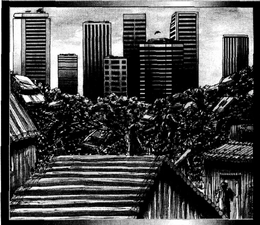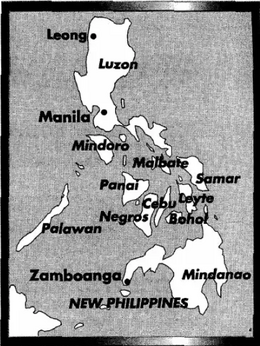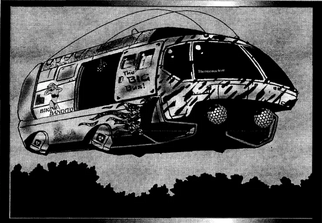The New Philippines is a country located in Southeast Asia consisting of 7,641 islands that are categorized under three main geographical divisions from north to south: Luzon, Visayas and Mindanao.
History[]
Throughout it's history 60% of the people in the New Philippines would make a living by fishing and aquatic culture; that's all been done away with. The cities are packed with poor and the gangs living in garbage and breathing opaque air. The countryside is full of Communist and Muslim rebels. The government is making money of SovOil and FACS, but little of that money actually goes past President "The bucks, yen, rubles, or whatever else stops here" Tiapon. Most of the Philippines is corporate run (Negros), or captured by rebels (Mindanao).
The people who like chaos and disorder then it's the place most find attractive. Manila has become the homing beacon for many punks to come. There is this just certain surrealism in this country. B-girls are readily available in a 90% Catholic Asian Nation. The country is filled with gun creators and weapon contractors that will fulfill any order.
By 2077, several food companies presumably of New Filipino origin operate in and around Night City, such as the restaurant chain Kabayan Foods, and the coffee brand Matapang Coffee. It is also mentioned that Kerry Eurodyne vacationed in the New Philippines for a while.
Government[]

Manila 2020
In reality the Government only really controls the main island of Luzon, and it's having trouble even just with the one island. The North side of the island is home of the New People's Army (NPA), yet another tiresome Maoist group. The islands of Mindanao, Palawan, and the Sulus are full of Moro National Liberation Front (MNLF), the Moslem faction, who really don't like being under the same government roof as a bunch of Catholics.
The pre-Corp war President General Ramos and his military comrades had stabilized the situation. When the oil was found in the Spratlys, he jumped on the SovOil side, hoping this would placate the NPA. However it didn't last, with the constant attacks on the corporate sites of Petrochem.
After the war, when the extant of the pollution hit home, Ramos was assassinated by angry ex-fisherman. President Aguilar was elected, and declared the New Constitution for the New Philippines in the 2011 elections. All sides agreed to vote, however later on it was discovered that Aguilar was caught cheating the system. The Army than allowed troops to vote where they were all stationed in rebel territories. The next president that was then elected, Lopez, was blown up in his inaugral parade.
Finally SovOil stepped in and helped General Antonio Taipon keep his hold on the presidency in 2013. The rebels were then pushed back to their home territories by SovOil troops, who had also make up the bulk of the Presidential Guard. Taipon had opened the door of FACS, for their massive investment abilities. While the government is a complete mess, Japan has a like for the country and buys a lot of import from the New Philippines.
Geography[]

New Philippines Map of 2020
The Philippines is an archipelago, or string of over 7,100 islands, in southeastern Asia between the South China Sea and the Pacific Ocean. The two largest islands, Luzon and Mindanao, make up for two-thirds of the total land area. Only about one third of the islands are inhabited.
Major Cities[]
Manila - 2.2 million[]
Manila is the capital city of New Philippines, but it is also the nastiest city in the country. Manila is one of the most densely populated cities in the world. The city is the capital city of the Philippines, and it is the economic, administrative, and social center of the nation. In contrast to other Asian countries, economic growth in the Philippines has been mainly concentrated on a single urban center. Manila generates nearly half the country's total Gross Domestic Product (GDP). Approximately 94% of the population in Manila is Malay-Indonesian by ethnicity with some European, Spanish, Chinese or American ancestry. The rest of the population is Chinese. The Tagalog language is widely spoken in the city while English is the official business and educational language. The residents are employed in the city's industries, such as textiles, food and tobacco processing, chemical manufacturing and coconut oil processing. Manila is also a vital seaport in the country. The Metropolitan is made up of 17 municipalities, which range from elegant business districts and affluent neighborhoods to slums and shanty towns. The economic growth in Manila has brought with it challenges such as overpopulation, drug use and crime, pollution, and traffic congestion. Overcrowding in the city has caused other problems such as inadequate health care, inadequate sanitation and a rise in poverty. The municipal agencies in Manila struggle to offer public services to the ever growing population.

An AV of 2020
Quezon City - 3.5 million[]
Quezon City is the biggest city in the Philippines by population. Confusingly, Quezon City does not actually have anything to do with Quezon province. The city is located in the Guadalupe Plateau. Quezon City experiences a tropical climate and is prone to heavy rains and even monsoons. The city has experienced a high degree of population growth over years, to the point where it has surpasses Manila to become the country's most populated city. Population growth is expected to continue.
Caloocan - 2 million[]
The name Caloocan comes from the Tagalog word meaning "innermost area". True to its name, the city of Caloocan is bordered by a number of large cities, including Manila and Quezon City. Today it is one of the largest cities in the Philippines with a population of 2,009,356.
Davao City - 1.8 million[]
Davao City had a population of 1,803,991 in 2020. The city is a trade, educational, and tourism center of the Davao region. The city is divided into 11 districts for effective and efficient administration. The city has been subject to an influx of rural immigrants. The ethnicity of Davao's population is diverse. Cebuanos and indigenous Davaoenos are the majority groups, while Illongos, Aeta, and Lumad form the minority ethnicities. Most of the residents are employed in the agricultural sector, because the Davao region is a major producer of bananas, coffee, coconut, and pineapple in Asia. Cacao production has been a growing trend in the region as well. Davao City has been confronted with the issue of sprawling informal settlements in the neighborhood. Traffic congestion and pollution continue to affect the livability situation of the city.
Reference[]
PASQUARETTE, C. Pacific Rim Sourcebook. 1st ed. Berkeley CA: R.Talsorian Games, 1994
